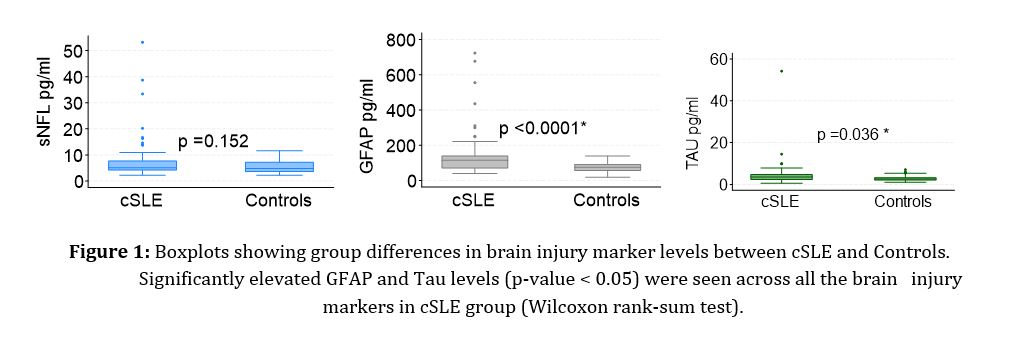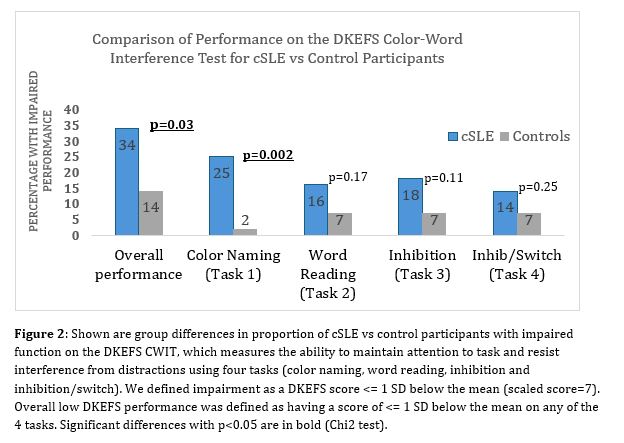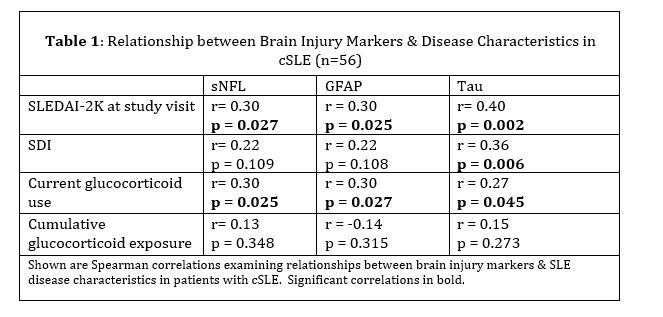Session Information
Session Type: Abstract Session
Session Time: 3:00PM-4:30PM
Background/Purpose: Patients with childhood-onset systemic lupus erythematosus (cSLE) commonly experience impaired executive function (EF), and attribution to neuropsychiatric lupus (NPSLE) is challenging. Serum markers of brain injury may be potential biomarkers for EF impairment due to SLE. We investigated the relationship between serum brain injury markers, EF and disease characteristics in cSLE.
Methods: We utilized prospectively-collected cross-sectional data from children with SLE (ages 12-17 years) recruited from the Lupus Clinic at a Canadian tertiary children’s hospital from January 2020–December 2023 and age-, sex-matched healthy controls. Serum brain injury marker levels for serum neurofilament light chain (sNFL), glial fibrillary acidic protein (GFAP), and Tau were quantified using the Simoa Human Neurology 4–Plex B assay (Quanterix, Billerca, MA, USA). EF was assessed using the Delis Kaplan Executive Function System (DKEFS) Color Word Interference test (CWIT) which measures the ability to inhibit an automatic response and switch between competing demands. A scaled score is generated for each of 4 tasks on the DKEFS CWIT. We defined impairment as a DKEFS score < = 1 SD below the mean (scaled score=7). Disease variables included disease activity (SLEDAI-2K), damage (SLICC damage index, SDI >0) and glucocorticoid (GC) exposure (prednisone-equivalent). We used non-parametric tests to compare brain injury marker levels and low EF status between the cSLE and control groups; and to examine correlations between the markers and i) DKEFS scores and ii) cSLE disease characteristics.
Results: Participants included 56 children with cSLE (mean age=15.1 years ± SD 1.8, 86% female) and 43 healthy controls (mean age=15.1 years ± 1.7, 81% female). For cSLE, the median disease duration was 22.6 months (IQR, 12.5-43.9), median SLEDAI-2K was 2.5 (IQR, 2-5.5), 13% had disease damage, and median cumulative GC dose (grams) was 1.85 (IQR, 0.6-6.9). One patient had a NPSLE diagnosis. There was a statistically significant difference between GFAP and Tau serum levels in cSLE vs controls (Figure 1). A higher proportion of children with cSLE vs controls (34% vs 14%, p=0.027) had low overall DKEFS performance, particularly for the color naming task (25% vs 2%, p=0.002 (Figure 2). In the cSLE group, worse DKEFS inhibition scores correlated with higher sNFL (r=-0.33, p=0.014) and Tau (r=- 0.26, p=0.057). In the cSLE group, higher levels of all three brain injury markers were significantly correlated with disease activity and current GC dose, and Tau showed a significant association with disease damage (Table 1).
Conclusion: Our study showed higher levels of brain injury markers and worse performance on the DKEFS in children with cSLE compared to controls. Brain injury markers correlated with impaired EF on the DKEFS inhibition task, as well as worse disease markers in the cSLE group. Further analyses will investigate the relationship between inflammation, brain injury and cognitive function in cSLE over time.
To cite this abstract in AMA style:
Mwizerwa O, Ledochowski J, El Tal T, Ramanathan G, Mossad S, Mohamed I, Law J, Ng L, Moaf P, Jeyanathan A, Davis A, Yeh A, Hiraki L, Levy D, Touma Z, Wither J, Zapparoli B, Danguecan A, Knight A. Brain Injury Markers Correlate with Impaired Executive Function and Disease Activity in Children with Systemic Lupus Erythematosus [abstract]. Arthritis Rheumatol. 2024; 76 (suppl 9). https://acrabstracts.org/abstract/brain-injury-markers-correlate-with-impaired-executive-function-and-disease-activity-in-children-with-systemic-lupus-erythematosus/. Accessed .« Back to ACR Convergence 2024
ACR Meeting Abstracts - https://acrabstracts.org/abstract/brain-injury-markers-correlate-with-impaired-executive-function-and-disease-activity-in-children-with-systemic-lupus-erythematosus/



